A trove of amulets, figurines, jewels and decorative pieces made of Egyptian faience, bronze, bone, amber, amethyst, stone, glass and crystal has been 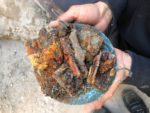 unearthed at Pompeii. The remains of wooden chest with bronze hinges were found in an excavation of the House of the Garden in Regio V, the same elegant villa where in 2018 a charcoal inscription indicating the eruption of Vesuvius took place on October 24th instead of the conventional August 24th date. The find site was not in the elegant part of the house, but rather in a corner of what is believed to have been a service area.
unearthed at Pompeii. The remains of wooden chest with bronze hinges were found in an excavation of the House of the Garden in Regio V, the same elegant villa where in 2018 a charcoal inscription indicating the eruption of Vesuvius took place on October 24th instead of the conventional August 24th date. The find site was not in the elegant part of the house, but rather in a corner of what is believed to have been a service area.
 Traces of the wood and the imprint of a box were preserved in the volcanic alchemy of that fateful day. The objects excavated from the imprint include two mirrors, numerous beads, a glass unguentarium, small phalluses, gemstone and glass intaglios (an artisan at work engraved into a carnelian, violet glass inscribed with the head of Dionysus, a dancing satyr engraved on an oval of clear glass, a spike
Traces of the wood and the imprint of a box were preserved in the volcanic alchemy of that fateful day. The objects excavated from the imprint include two mirrors, numerous beads, a glass unguentarium, small phalluses, gemstone and glass intaglios (an artisan at work engraved into a carnelian, violet glass inscribed with the head of Dionysus, a dancing satyr engraved on an oval of clear glass, a spike 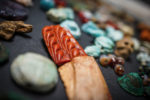 of wheat carved out of amber), bronze bracelets, bronze bells, faience and amethyst scarabs, human and animal figures, buttons and a skull carved out of bone.
of wheat carved out of amber), bronze bracelets, bronze bells, faience and amethyst scarabs, human and animal figures, buttons and a skull carved out of bone.
 The contents mark the chest as more than a simple jewelry box, although there are numerous pieces of personal adornment that would have been worn by a woman like the amber beads and bronze bracelets. The figurines, scarabs, skulls, phalluses and other objects were protective amulets, figures and symbols with apotropaic value (ie, the power to ward off the evil eye, curses, etc.). Phalluses and
The contents mark the chest as more than a simple jewelry box, although there are numerous pieces of personal adornment that would have been worn by a woman like the amber beads and bronze bracelets. The figurines, scarabs, skulls, phalluses and other objects were protective amulets, figures and symbols with apotropaic value (ie, the power to ward off the evil eye, curses, etc.). Phalluses and 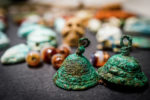 Harpocrates, the Greek syncretic version of Horus, son of Isis and Serapis, were common presences in Roman households as protectors of children and mothers. Wheat was a symbol of prosperity. The chiming of bells chased away bad luck. The closed fist, the skull, the scarabs were all good luck charms.
Harpocrates, the Greek syncretic version of Horus, son of Isis and Serapis, were common presences in Roman households as protectors of children and mothers. Wheat was a symbol of prosperity. The chiming of bells chased away bad luck. The closed fist, the skull, the scarabs were all good luck charms.
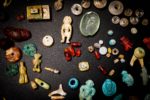 In this villa, archaeologists found the remains of 10 victims of Vesuvius’ fury, among them women and children. Researchers are attempting to establish the connection between the 10, whether they were related, with DNA analysis. It’s possible that the chest
In this villa, archaeologists found the remains of 10 victims of Vesuvius’ fury, among them women and children. Researchers are attempting to establish the connection between the 10, whether they were related, with DNA analysis. It’s possible that the chest 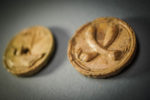 of treasures belonged to one of these women. It was unlikely to be the property of the lady of the house because there was no gold at all in the box, and a member of this wealthy family would certainly have owned gold pieces as it was de rigeur among the moneyed elites of Pompeii in 79 A.D.
of treasures belonged to one of these women. It was unlikely to be the property of the lady of the house because there was no gold at all in the box, and a member of this wealthy family would certainly have owned gold pieces as it was de rigeur among the moneyed elites of Pompeii in 79 A.D.
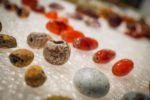 The artifacts have been conserved and will soon go on display in a new exhibition dedicated to the style and manufacture of jewels unearthed in Pompeii.
The artifacts have been conserved and will soon go on display in a new exhibition dedicated to the style and manufacture of jewels unearthed in Pompeii.
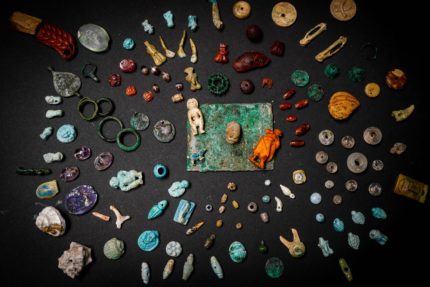
Beads, but no buttons (?) When did the use of buttons for garment-closure come in?
Beads, but no buttons (?) When did the use of buttons for garment-closure come in?
old peoples have liking
Would witchcraft be illegal in, let’s say, Canada? :boogie:
“…fraudulently pretend to exercise or to use any kind of witchcraft, sorcery, enchantment or conjuration” (cf. sec. 365 of Canada’s Criminal Code). –It is not unheard of that trafficked women end up in prostitution rings, or are e.g. sent on a burglary spree, to pay off their massive debts to organized crime.
Back in the early 90s, I did service in a mental asylum for women, and on one occasion on a night shift, cops came by and presented a middle aged black lady that they had caught shoplifting earlier. As I had been the only one that was able to communicate with her, it was onto me to deal with the admission. In my interview in the middle of the night, she suddenly presented an arrangement of amulets and talismans that she allegedly had been sent on her shopping tour with by her ‘Marabout’ sorcerer, who had his home base in Brussels/ Belgium.
Herself she was rather laid back, in stupor, she did not understand a word, or just pretended. Unfortunately, I do not know if and how the story ended. She spent a couple of days in there, before she was probably released. My records and all the hard effort as ‘witch finder’, however, were possibly taken too lightly! To be precise, she was a victim, but obviously not the only one.
—————————————–
P.S.: In Canada, I hear, the conviction would possibly lead to a C$2,000 fine and up to six months in jail, but I was notably on the wrong Continent! 😮
I tried posting this last night but for some reason it did not show up in the comments section.
The toroid objects on the right of the large photo which appear to be made of quartz may be spindle whorls rather than beads. Spinning has commonly been associated with women and femininity. The only real way to distinguish a whorl from a bead other than archeological context is the size of the hole. A bead only has to have a hole large enough for a string or fine chain. A whorl has to have a hole large enough for the stick or rod used as the spindle. There is no need to drill a hole larger than necessary in a hard material such as quartz.
That is not to say that whorls haven’t been strung on necklaces or that large beads haven’t been used a spindle whorls.
In response to a previous comment: Buttons, in the form of toggles, have been around since the Neolithic. Discoid buttons with 2 or more perforations did not become common until the late middle ages IIRC.
Thirteenth-century Germany, apparently, though most medieval buttons seem to have been ornamental. See Wikipedia on Buttons.
Tacitus, ‘Historiae’ (book 2) on Aulus Caecina Alienus]:
—-
… ipsius municipia et coloniae in superbiam trahebant, quod versicolori sagulo, bracas barbarum tegmen indutus togatos adloqueretur. …towns and colonies took it as his as haughtiness that wearing a parti-coloured cloak and trousers of the Barbarians he adressed civilians.
—-
Galba appointed him to the command of Legio IV Macedonica at Mogontiacum in Upper Germany. Having been prosecuted for embezzling public money, Caecina went over to Vitellius, who sent him with a large army –via what today is Switzerland– into Italy. He was later killed, but probably at least the trousers were suspended :no:
Some great objects. Will these go on display at Pompeii or will it be the Naples museum?
There are two voodoo dolls: One is metric, another is standard.
Just to say thanks for your blog, and I wonder if it’s possible to install a ‘like’ button?
thanks for sharing
Just wanted to mention that the glass with the Dionysus carving looks like a tektite. It has elongated bubbles and what appear to be lechatelierite inclusions.
Greetings,
There is one object in the group that no one has commented on anywhere that I have read, It appears to be a small, rectangular, two piece box-like object with a possibly sliding lid. It shows up in most of the images found on the web. The tiny lid has sloping sides like a pyramid, with a little rectangular handle on top. Visible in some images, you can make out a circular depression as if for a coin (?). Any ideas out there ?
Thanks